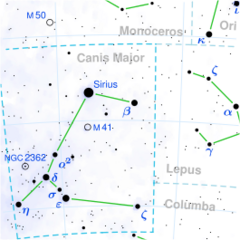Astronomy:Nu2 Canis Majoris
| Observation data Equinox J2000.0]] (ICRS) | |
|---|---|
| Constellation | Canis Major |
| Right ascension | 06h 36m 41.03758s[1] |
| Declination | −19° 15′ 21.1659″[1] |
| Apparent magnitude (V) | 3.96[2] |
| Characteristics | |
| Spectral type | K1 III[2] |
| Astrometry | |
| Radial velocity (Rv) | +2.57±0.14[3] km/s |
| Proper motion (μ) | RA: +62.57±0.15[1] mas/yr Dec.: −69.97±0.16[1] mas/yr |
| Parallax (π) | 50.63 ± 0.23[1] mas |
| Distance | 64.4 ± 0.3 ly (19.75 ± 0.09 pc) |
| Absolute magnitude (MV) | 2.47[2] |
| Details[4] | |
| Mass | 1.3±0.1 M☉ |
| Radius | 4.9±0.1 R☉ |
| Luminosity | 11.3±0.1 L☉ |
| Surface gravity (log g) | 3.18±0.03 cgs |
| Temperature | 4,790±27 K |
| Metallicity [Fe/H] | 0.21±0.10 dex |
| Rotational velocity (v sin i) | 1.97±0.23[3] km/s |
| Age | 4.6±0.7 Gyr |
| Other designations | |
| Database references | |
| SIMBAD | data |
Nu2 Canis Majoris (ν2 Canis Majoris) is a single[5] star in the southern constellation of Canis Major. It is a cool giant with two confirmed exoplanets.
Characteristics
With an apparent visual magnitude of 3.96,[2] it is bright enough to be seen with the naked eye to the southwest of Sirius. It has an annual parallax shift of around 50.63 mas as seen from Earth,[1] thus this system is about 64.4 light years from the Sun, a parallax well within the error margins of the figure later given by the Gaia space observatory data release 2, namely 50.471 ± 0.4168.[6]
It is an evolved K-type giant around 4.6 billion years old. Around 1.3 times as massive as the Sun, it has expanded to around 4.9 times the Sun's diameter and 11 times its luminosity.[4] In 2011, it was found to have a planet.[7]
Chinese name
In Chinese astronomy, ν2 Canis Majoris is called 野雞, Pinyin: Yějī, meaning Wild Cockerel, because this star is marking itself and stand alone in Wild Cockerel asterism, Well mansion (see : Chinese constellation).[8] 野雞 (Yějī), westernized into Ya Ke. According to R.H. Allen opinion, the name Ya Ke is asterism consisting ο1 Canis Majoris and π Canis Majoris, with other small stars in the body of the Dog[9]
Planetary system
By measuring periodic variations in the radial velocity of the host star between 2009 and 2010, the Pan-Pacific Planet Search program was able to identify a planet orbiting Nu2 Canis Majoris. An orbital fit produced a minimum mass estimate of 2.6±0.6 |♃|J}}}}}}with an orbital period of 2.1 years and an eccentricity of 0.23. Star spots were ruled out as a source for the signal with a false-alarm probability of 98.7%.[7] Further observations through 2019 detected the planet, as well as a secondary planet c in a 4:3 orbital resonance with planet b.[10]
| Companion (in order from star) |
Mass | Semimajor axis (AU) |
Orbital period (days) |
Eccentricity | Inclination | Radius |
|---|---|---|---|---|---|---|
| b | ≥1.895 MJ | 1.761 | 736.9 | 0.055 | — | — |
| c | ≥0.609 MJ | 2.143 | 988.9 | 0.046 | — | — |
References
- ↑ Jump up to: 1.0 1.1 1.2 1.3 1.4 1.5 van Leeuwen, F. (2007). "Validation of the new Hipparcos reduction". Astronomy and Astrophysics 474 (2): 653–664. doi:10.1051/0004-6361:20078357. Bibcode: 2007A&A...474..653V. Vizier catalog entry
- ↑ Jump up to: 2.0 2.1 2.2 2.3 Setiawan, J. et al. (July 2004), "Precise radial velocity measurements of G and K giants. Multiple systems and variability trend along the Red Giant Branch", Astronomy and Astrophysics 421: 241–254, doi:10.1051/0004-6361:20041042-1, Bibcode: 2004A&A...421..241S.
- ↑ Jump up to: 3.0 3.1 Jofré, E. et al. (2015), "Stellar parameters and chemical abundances of 223 evolved stars with and without planets", Astronomy & Astrophysics 574: A50, doi:10.1051/0004-6361/201424474, Bibcode: 2015A&A...574A..50J.
- ↑ Jump up to: 4.0 4.1 Bonfanti, A. et al. (2015). "Revising the ages of planet-hosting stars". Astronomy and Astrophysics 575: A18. doi:10.1051/0004-6361/201424951. Bibcode: 2015A&A...575A..18B. http://www.aanda.org/articles/aa/full_html/2015/03/aa24951-14/aa24951-14.html.
- ↑ Eggleton, P. P.; Tokovinin, A. A. (September 2008), "A catalogue of multiplicity among bright stellar systems", Monthly Notices of the Royal Astronomical Society 389 (2): 869–879, doi:10.1111/j.1365-2966.2008.13596.x, Bibcode: 2008MNRAS.389..869E.
- ↑ Brown, A. G. A. (August 2018). "Gaia Data Release 2: Summary of the contents and survey properties". Astronomy & Astrophysics 616: A1. doi:10.1051/0004-6361/201833051. Bibcode: 2018A&A...616A...1G. Gaia DR2 record for this source at VizieR.
- ↑ Jump up to: 7.0 7.1 Wittenmyer et al. (2011). "The Pan-Pacific Planet Search. I. A Giant Planet Orbiting 7 CMa". The Astrophysical Journal 743 (2): 184. doi:10.1088/0004-637X/743/2/184. Bibcode: 2011ApJ...743..184W.
- ↑ (in Chinese) AEEA (Activities of Exhibition and Education in Astronomy) 天文教育資訊網 2006 年 7 月 16 日
- ↑ Richard Hinckley Allen: Star Names — Their Lore and Meaning: Canis Major
- ↑ Jump up to: 10.0 10.1 Luque, R.; Trifonov, T.; Reffert, S.; Quirrenbach, A.; Lee, M. H.; Albrecht, S.; Andersen, M. Fredslund; Antoci, V. et al. (13 October 2019). "Precise radial velocities of giant stars XIII. A second Jupiter orbiting in 4:3 resonance in the 7 CMa system". Astronomy & Astrophysics A136: 631. doi:10.1051/0004-6361/201936464. Bibcode: 2019A&A...631A.136L.
External links
 |


